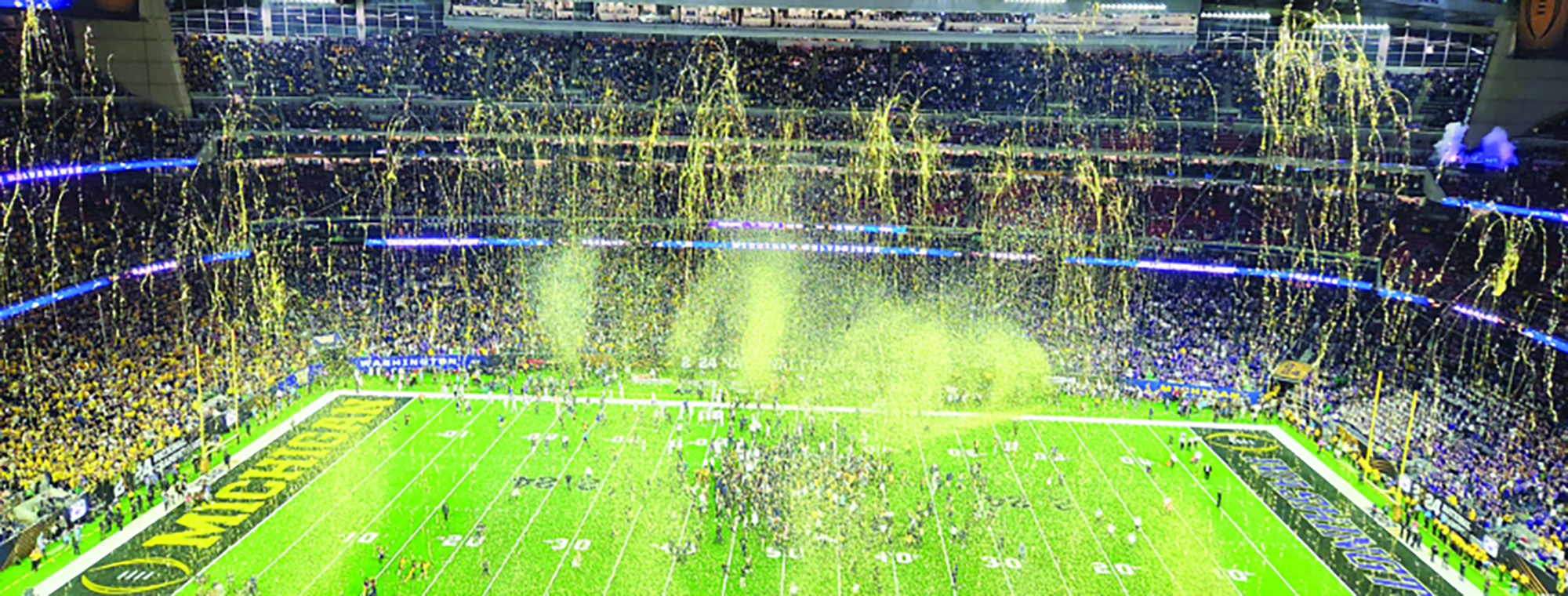Confessions of a once reluctant Michigan Wolverine
By Jacob Wheeler
Current Contributor
I admit it: I tried hard to not become a University of Michigan football fan.
As a freshman in Ann Arbor in the fall of 1996, I found myself turned off by the manic—even cultish—obsession with the team, and the worship that transpired each autumnal Saturday.
During new student orientation and again during “welcome week” in August, the chorus of voices chanted about the Big House, about Bo Schembechler, and implored us to sing “Hail to the Victors” in unison. From the Student Union, our tornado of wide-eyed 18-year-olds marched down State and Hill streets to Elbel Field, where the marching band paraded before us. Trumpets, tubas, drums, Hail, patriotism, violent/smashmouth football, Hail, Hail to Michigan, the champions of the west!
I found it superficial and arrogant. This was not what had attracted me to choose U of M for college. No, I wanted the great university—and within it, the intimate Residential College, with its focus on foreign languages and creative arts. I wanted the vibrant college town, the oasis for radical and revolutionary politics. Indecisive of whether I should choose Michigan or Michigan State, I followed my father’s excitement as he reminisced about his Olivet College days in the early ’70s and sometimes meandering through Ann Arbor.
Here was Hash Bash and the Naked Mile; the alternative bookstores along Liberty Street and the large mural of Woody Allen, Edgar Allen Poe and Franz Kafka; the coffee shops and onetime stomping grounds of Arthur Miller and Tom Hayden; here at the Michigan Union was where John F. Kennedy had announced the Peace Corps.
I wanted this, not Hail, Hail.
During my freshman year, I gobbled up everything—the way a hungry boy raised deep in the woods ought to. That included buying student-priced season tickets and joining the football worship sessions on Saturday home games. But the Wolverines were mediocre that year; they lost four games and finished in the middle of the Big Ten standings. The following year, I did not re-up on tickets.
Then, a funny thing happened.
In 1997, Michigan ran the table and won every single game. They were a dynamic team led, in part, by Charles Woodson, who would become the first primarily defensive player to win the Heisman Trophy. The Wolverines hosted archrival Ohio State on November 22, with the winner headed to the Rose Bowl and quite possibly a national championship title.
I had to be there.
Though I was a broke undergraduate, I coughed up $120 for a ticket. Michigan won, 20-14; thousands of us in the student section stormed the field, even as the state police tried to subdue us with tear gas; and the whole town got drunk together. Then-president of the university, Lee Bollinger, invited hundreds of students dancing in his front yard into his house—a kid who lived down the hall from me even scored a beer from Bollinger’s fridge. On January 1, Michigan won the Rose Bowl and later an invitation to The White House to meet then-president Bill Clinton (D).
I was hooked. I sang Hail, Hail to Michigan, the champions of the west! and I sang it with gusto.
What I experienced on that cold, late-November day at the Big House was not about football, or even sports. It was the power of unity, of euphoria among strangers, of a trance as thousands of us move together in the same rhythm, with the same objective. I’ve felt that in other places, too—an underground rave in Berlin, or Obama’s first presidential election night victory in his city, Chicago’s Grant Park—and I have seen it in houses of worship, even at emotionally charged gatherings like weddings or funerals.
Jaime Lowe wrote in a recent op-ed in The New York Times—prior to Michigan playing in this year’s Rose Bowl—that, in Michigan’s football stadium, she “felt delirious joy, meditative peace, a sense of comfort.” She was “swept up in frenetic joy. It was as if we, the fans, were a superorganism.” Lowe cited the Stanford literature professor Hans Ulrich Gumbrecht, who wrote a book about crowds and stadiums as a “ritual of intensity.” He covered the idea that crowds can open humans up to experiences beyond ourselves.
After my undergraduate years in Ann Arbor, I did not play close attention to Michigan football. I tuned in only when the Ohio State game arrived or when the Wolverines played in an important bowl game. My curiosities were elsewhere. I lived in Europe, in Central America, and bounced around the Midwest. It mattered little—the team was once again mediocre and wallowed in obscurity through various head coaches. During the pandemic-shortened 2020 season, they won a pathetic two games. I didn’t teach my kids the fight song.
But this season, as Michigan beat Ohio State for the third straight November, earning a berth in the Rose Bowl and a chance to play for the national championship, the words Hail, Hail found their way into my children’s bedtime songs. I couldn’t help it. And when the Wolverines beat Alabama in a dramatic overtime victory on January 1 and punched their ticket to Houston for the title game, I felt the euphoria that I had first experienced as an excited 20-year-old.
My nine-year-old daughter insisted on wearing maize-and-blue colors to school and declaring to her closest classmate—a diehard Spartan fan—that she would attend college in Ann Arbor. I cautioned her, “Nina, it’s only a game. It’s not that important.” But who was I kidding? And who was I really counseling?
On January 8, 2024,I watched the national championship with both friends and strangers at The Little Fleet, Traverse City’s hip cocktail lounge which was founded by a couple U-M grads who met each other during college in the ’90s. We were all in our mid-40s now—adults with responsibilities—but we sought that kinship, that unity.
Michigan dominated the first and fourth quarters and won the game handily, 34-13. But my favorite memory of that golden night was when my friend—an English lecturer in Ann Arbor who admitted she knows nothing about football—began to read the players’ names on their jerseys as they marched down the field in Houston to score touchdowns.
“I had him in my class last spring!” she exclaimed, as tight end Colston Loveland caught a pass. “I had him, too!” she said, as boyish-faced quarterback J.J. McCarthy danced out of the pocket to find a wide receiver downfield.
After the maize-and-blue confetti fell from the rafters and we sang Hail, Hail to Michigan, she recalled the personal essays they had written, and what those words offered about their hopes and vulnerabilities. They, too, are 20-year-old kids now dancing in that trance of unity and unbridled joy. They are national champions. Go Blue!
A version of this article first published in the Glen Arbor Sun, a Leelanau County-based semi-sister publication to The Betsie Current.
Editor’s Note: Similarly, our co-owners, Jordan B. Bates and Aubrey Ann Parker, are also graduates of the University of Michigan, though Parker is more reluctantly interested in Wolverine football than Wheeler and Bates is decidedly more so.
Featured Photo Caption: Players celebrated on the field in a haze of Maize and Blue after the University of Michigan Wolverines won the national championship in Houston on January




